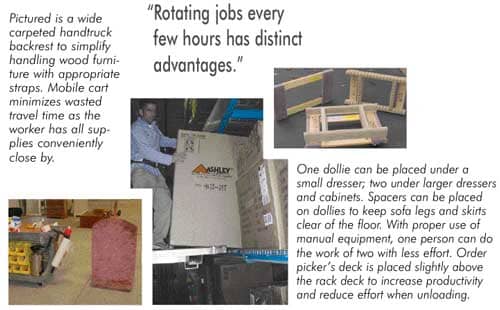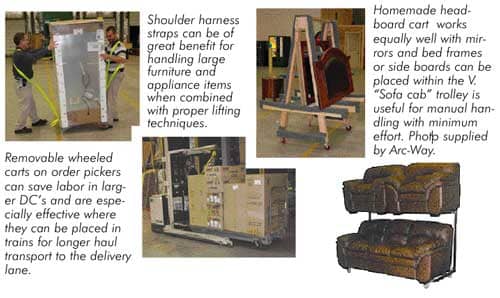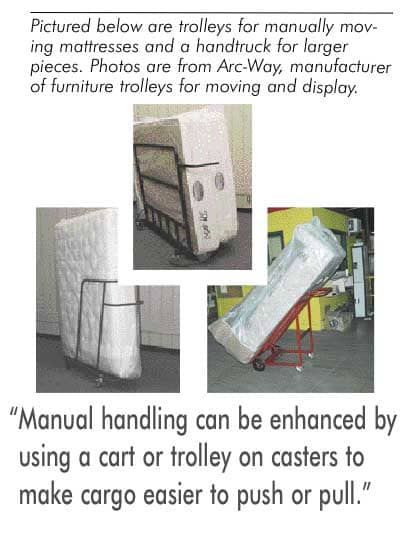Manual moving techniques for increasing productivity and preventing injuries.
Delivery, Warehousing, Logistics by Dan Bolger & Ken Ackerman
For thousands of years, humans have handled cargo manually. Visitors to ancient structures in Egypt and Peru are mystified by ancient peoples’ apparent ability to lift and move heavy materials without mechanical aids.
In our current era of robotics and other high-tech solutions, it is easy to overlook the necessity and importance of manual handling. In many stages along the furniture warehouse and delivery route, impediments to proper handling exist. In crowded warehouses there may not be sufficient space to allow mechanical handling. Furniture wrapping or cartoning may provide minimal protection when handled with conventional fork lifts. In customers’ homes the challenge isn’t the final mile, but rather the final 100 feet. Crews delivering furniture and appliances to residences, stores or offices have to contend with vehicle unloading, stairways, narrow doors, tight corners and low headroom clearances.

During warehouse operations consulting assignments I see many operations where low productivity within the warehouse and “final mile” delivery can be magically improved by applying simple techniques of ancient workers.
The problem of excessive number of workers compensation claims in our industry can be addressed as well with simple, common sense inventory placement techniques and training. Manual handling is unavoidable.

Good ergonomics is the business of helping people work smarter, not harder. It requires arrangement of the work to minimize the possibility of excess fatigue and personal injury. Ergonomics is of particular importance in manual handling, simply because the process offers a major risk of injury.

While prevention of injuries is an important motivator for good ergonomics, another important benefit is improved productivity. When the work is easier to perform, people are more productive. When management arranges the workplace efficiently, workers get the job done with less physical effort and therefore are able to move more pounds of cargo every day.
One way to improve ergonomics is to avoid any condition that causes a strain in manual handling. Twisting is particularly dangerous if it is done while lifting or handling cargo. Repetitive motions can cause injury, commonly called cumulative trauma disorder or CTD. Use common sense and consider the following practices.
- Minimize situations which cause the worker to stoop to the floor or reach overhead while handling cargo.
- Plan the location of, for example, merchandise that is typically sold together, to minimize walking distances.
- Perform order picking in a “Z” pattern. The picker selects from one side of the aisle and then immediately selects merchandise directly across the aisle.
Magline, Inc. a manufacturer of manual handling equipment, describes the ergonomic challenges this way:
What is the difference between a weightlifter and a route driver?
- The average delivery crew will lift about 24,000 pounds per day.
- Weightlifters stretch before and after they lift weights, most drivers do not.
- Weightlifters give their muscles a minimum one day break to recuperate.
- Delivery crews continue to use muscles, creating repetitive strain.
Within the warehouse, rotating jobs every few hours has distinct advantages. Job rotation allows workers to do different tasks and minimizes the possibility that a repetitive lifting situation could cause injury. It also allows workers to cross train and develop new skills, avoiding boredom. Jobs should be designed for micro-breaks, and workers should be trained to use these breaks to plan ahead as well as to avoid fatigue.
Attention to proper slotting is essential to improve ergonomics by minimizing stretching and bending. Fast movers or tough to handle items should be placed in the “golden zone”. This is the height between an average worker’s belt and shoulder. Control of inbound put-away is necessary to maintain the golden zone.
Placing the order picker’s platform slightly above the rack deck when unloading tall items reduces the effort to transfer merchandise. When retrieving merchandise, put the order picker’s deck slightly below the rack deck to increase productivity and reduce effort. Automatic retracting safety harnesses are far more effective than straps.
Manual handling can be enhanced by using a cart or trolley on casters to make cargo easier to push or pull. Sometimes a two wheel hand truck is adequate but the addition of a wider carpeted backrest simplifies handling wood furniture with appropriate straps. Some hand trucks are designed to go up and down stairs yet they are not frequently seen on furniture delivery trucks.
Check out the photos and captions that accompany this article for additional tips and techniques. Manual cargo handling has always been with us and is likely to be an essential part of warehousing in the future. Following good ergonomic principles is absolutely critical, both for safety and productivity. While the need for manual handling continues, there is a wide selection of hardware designed to make the process easier.
Note: Thanks to my long time fellow consultant and friend, Ken Ackerman for his contributions to this article. We have worked together on many projects to boost profitability and customer response through logistics, facilities and management. Ken also publishes a monthly newsletter summarizing newsworthy articles relating to logistics and warehousing. Subscriptions to Ken's newsletter and his book Warehousing Profitably, 3rd Edition are available at http://warehousing-forum.com.
Daniel Bolger P.E. provides operations consulting services to clients throughout North America. FURNITURE WORLD Magazine readers can contact him at bolger@furninfo.com or phone 740-503-8875. For more information on transportation, logistics and furniture warehousing topics, go to FURNITURE WORLD Magazine’s website www.furninfo.com to read all of Dan’s articles.